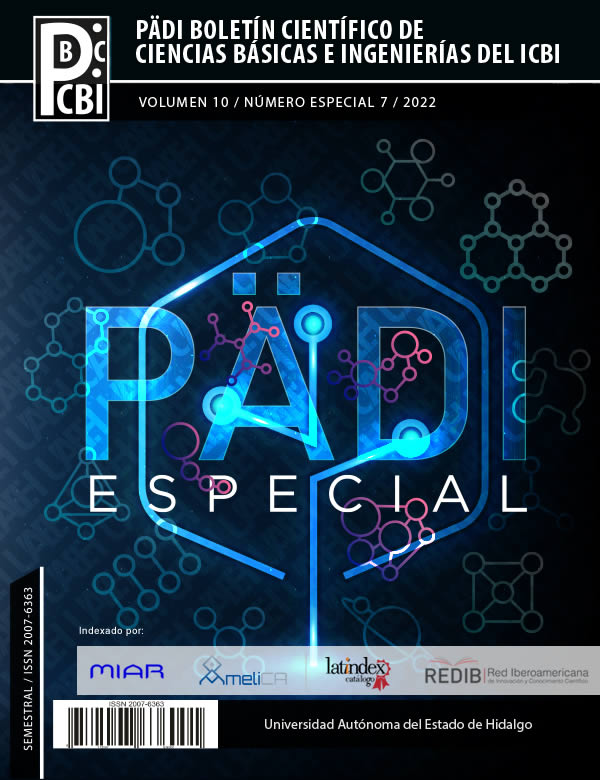Voltammetric determination of the frontier orbitals of Pd(II) complexes for their potential application in optoelectronic devices.
Abstract
The determination of the frontier orbitals (HOMO and LUMO) of a pair of organometallic compounds (PdCl2L and PdBr2L) is reported. This type of compounds have gained great interest due to their promising properties and application in optoelectronics, since they combine the advantages of organic and inorganic materials, their potential use is largely determined by the values of their frontier orbitals. Among the methods used to know this information, cyclic voltammetry is considered, which allows to determine indirectly these energy levels by determining the potentials of the beginning of the oxidation and reduction processes of the molecules under study. The PdCl2L and PdBr2L complexes were characterized by the mentioned method, and with the data obtained the frontier orbitals and bandgap were calculated. According to the results, the values are within the range reported for semiconductors, indicating that the complexes are viable to be used in the fabrication of optoelectronic devices.
Downloads
References
Elgrishi, N., Rountree, K. J., McCarthy, B. D., Rountree, E. S., Eisenhart, T. T., y Dempsey, Jillian L., (2018). A Practical Beginner’s Guide to Cyclic Voltammetry. Journal of Chemical Education, 95, 2, 197–206. DOI: 10.1021/acs.jchemed.7b00361
Fuentes, A. S., Filippin, A.F., Aguirre, M. del C. (2015). Pd Nucleation and Growth Mechanism Deposited on Different Substrates. Procedia Materials Science, 8, 541–550. DOI: 10.1016/j.mspro.2015.04.107
Gervaldo, M., Funes, M., Durantini, J., Fernandez, L., Fungo, F. y Otero, L. (2010). Electrochemical polymerization of palladium (II) and free base 5,10,15,20-tetrakis(4-N,N-diphenylaminophenyl)porphyrins: Its applications as electrochromic and photoelectric materials. Electrochimica Acta, 55(6), 1948–1957. DOI: 10.1016/j.electacta.2009.11.014
Gónzalez-Montiel, S., Sandoval-Chávez, C. I., Castillo-Moreno, M. A., Mendoza-Espinosa, D., Vásquez-Pérez, J. M., Cruz-Borbolla, J. y Salazar-Pereda, V., (2021). Coordination from heteroscorpionate ligand towards Pd(II) via Pd⋅⋅⋅Hδ−C(sp3) interaction: structural and catalytic studies. European Journal of Inorganic Chemistry, 26, 2661-2668. DOI: 10.1002/ejic.202100351
Hernández-Ortiz, O. J., Cerón-Castelán, J. E., Muñoz-Pérez, F. M., Salazar-Pereda, V., Ortega-Mendoza, J. G., Veloz-Rodríguez, M. A., Vázquez-García, R. A., et al., (2020). Synthesis, optical, electrochemical, and magnetic properties of new ferrocenyl chalcone semiconductors for optoelectronic applications. Journal of Materials Science: Materials in Electronics, 31(4), 3342–3353. DOI: 10.1007/s10854-020-02882-1
Jesuraj, P. J., Somasundaram, S., Kamaraj, E., Hafeez, H., Lee, C., Kim, D., Won, S. H., Shin, S. T., Song, M., Kim, C. S., Park, S. y Ryu, S. Y. (2020). Intramolecular charge transfer-based spirobifluorene-coupled heteroaromatic moieties as efficient hole transport layer and host in phosphorescent organic light-emitting diodes. Organic Electronics, 85, 105825. DOI: 10.1016/j.orgel.2020.105825
Kim, S., Lee, M., Hong, C., Yoon, Y., An, H., Youn, Y., Han, S., et al. (2020). A band-gap database for semiconducting inorganic materials calculated with hybrid functional. Scientific Data, 7(1). DOI: 10.1038/s41597-020-00723-8
Liu, S., Wang, Y.-C., Chang, C.-M., Yasuda, T., Fukui, N., Maeda, H., Long, P., Nakazato, K., Jian, W.-B., Xie, W.,
Tsukagoshi, K. y Nishihara, H. (2020). Solution-processed organometallic quasi-two-dimensional nanosheets as a hole buffer layer for organic light-emitting devices. Nanoscale, 12(13), 6983–6990. DOI: 10.1039/D0NR00240B
Pflock, S., Beyer, A., Müller, L. y Burzlaff, N. (2017). Homoleptic, di- and trivalent transition metal complexes with monoanionic N,N,O-heteroscorpionate ligands: Potential redox mediators for dye-sensitized solar cells? Polyhedron, 125, 34–43. DOI: 10.1016/j.poly.2016.08.011
Popczyk, A., Aamoum, A., Migalska-Zalas, A., Płóciennik, P., Zawadzka, A., Mysliwiec, J. y Sahraoui, B. (2019). Selected organometallic compounds for third order nonlinear optical application. Nanomaterials, 9(2), 1–15. DOI: 10.3390/nano9020254
Sathiskumar, S. y Balakrishnan, T. (2022). Laser damage threshold, antimicrobial efficacy and physicochemical properties of an organometallic L-proline lithium chloride monohydrate single crystal for NLO application and optoelectronic device fabrication. Journal of Materials Science: Materials in Electronics, 33(25), 20280–20292. DOI: 10.1007/s10854-022-08844-z
Shanmuga Sundar, G. J., Ravi Kumar, S. M., Sagayaraj, P., Selvakumar, S., Shanthi, C., Sivaraj, S. y Gunaseelan, R. (2021). Structural, mechanical, thermal, electrical, second- and third-order nonlinear optical characteristics of MCBT NLO crystal for optoelectronics device and laser applications. Bulletin of Materials Science, 44(3). DOI: 10.1007/s12034-021-02491-6
Smolentsev, G., Milne, C. J., Guda, A., Haldrup, K., Szlachetko, J., Vogt, M., et al. (2020). Taking a snapshot of the triplet excited state of an OLED organometallic luminophore using X-rays. Nature Communications, 11(1), 1–9. DOI: 10.1038/s41467-020-15998-z
Song, W. L., Mao, H. T., Shan, G. G., Gao, Y., Cheng, G. y Su, Z. M. (2019). Organometallic Ir(III) Phosphors Decorated by Carbazole/Diphenylphosphoryl Units for Efficient Solution-Processable OLEDs with Low Efficiency Roll-Offs. Inorganic Chemistry, 58(20), 13807–13814. DOI: 10.1021/acs.inorgchem.9b01601
Sworakowski, J. (2018). How accurate are energies of HOMO and LUMO levels in small-molecule organic semiconductors determined from cyclic voltammetry or optical spectroscopy?. Synthetic Metals, 235, 125–130. DOI: 10.1016/j.synthmet.2017.11.013
Taboukhat, S., Kichou, N., Fillaut, J. L., Alévêque, O., Waszkowska, K., Sahraoui, B., et al. (2020). Transition metals induce control of enhanced NLO properties of functionalized organometallic complexes under laser modulations. Scientific Reports, 10(1), 1–15. DOI: 10.1038/s41598-020-71769-2
Wang, J., Li, J., Zhou, Y., Yu, C., Hua, Y., Yu, Y., Li, R., Lin, X., Chen, R., Wu, H., Xia, H., & Wang, H. L. (2021). Tuning an Electrode Work Function Using Organometallic Complexes in Inverted Perovskite Solar Cells. Journal of the American Chemical Society, 143(20), 7759–7768. https://doi.org/10.1021/jacs.1c02118
Wong, W. Y., & Ho, C. L. (2010). Organometallic photovoltaics: A new and versatile approach for harvesting solar energy using conjugated polymetallaynes. Accounts of Chemical Research, 43(9), 1246–1256. https://doi.org/10.1021/ar1000378
Zhou, H., Cui, X., Yuan, C., Cui, J., Shi, S. y Yin, J., (2018). Band-Gap Tuning of Organic–Inorganic Hybrid Palladium Perovskite Materials for a Near-Infrared Optoelectronics Response. American Chemical Society Omega, 3, 10, 13960–13966. DOI: 10.1021/acsomega.8b02012













